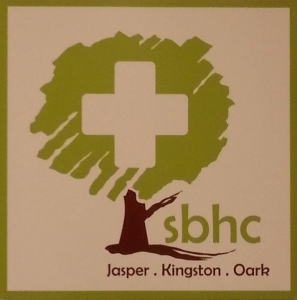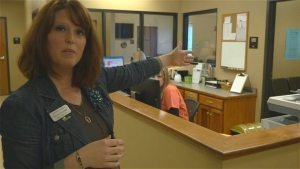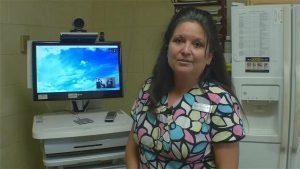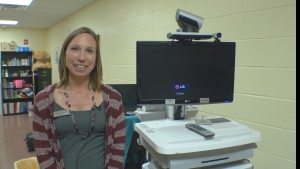 Located in the rural northwest area of Arkansas, the Jasper School District serves 898 students and encompasses three campuses, three towns and three counties. The district is located in a medically-underserved area, which means there is limited access to healthcare professionals and resources. Many residents fall below 200% of the Federal Poverty Level and/or are uninsured.
Located in the rural northwest area of Arkansas, the Jasper School District serves 898 students and encompasses three campuses, three towns and three counties. The district is located in a medically-underserved area, which means there is limited access to healthcare professionals and resources. Many residents fall below 200% of the Federal Poverty Level and/or are uninsured.
In 2012, the district received funds from the Arkansas Department of Education and the Arkansas Tobacco Excise Tax to build a school-based health center to serve the district and the community. The health center, completed in time for the 2013-14 school year, is located on the Jasper campus. Satellite offices exist on the Kingston and Oark school campuses.
The center has partnered with various providers to ensure quality healthcare services. Medical services, including care for acute and chronic disease, are provided by Boston Mountain Rural Health Centers; dental services are provided by Hubbard Dental Care, the only dental office in Newton County; and mental health services are provided for students through YouthBridge.
Partnering with Boston Mountain Rural Health Center
When looking for a medical provider for the center, Nicole Fairchild, School-Based Health Center (SBHC) Coordinator, said, “Jasper called all medical partners in the region looking for the best fit.” In 2014, the district partnered with the Boston Mountain Rural Health Center, based in Marshall.
Kortni Dixon, Chief Information Officer for Boston Mountain Rural Health Center, said, “We were approached by the Jasper School District to provide school-based services. After meeting with school officials and members of the community, we felt we could provide the healthcare resources that these communities need.”
The partnership with Boston Mountain Rural Health Center opened the door for the use of Telemedicine. In August, 2015, Arkansas e-Link, a grant-funded project by the American Reinvestment and Recovery Act, installed Telemedicine clinical carts at each location. In October, 2015, clinic staff were trained on the capabilities of the clinical carts. Additional training will be provided by the University of Arkansas for Medical Sciences, Center for Distance Health, on peripherals that can be attached to the cart, such as scopes, pulse ox and weight scales.
Telemedicine services will be rolled out by January, 2016.
To better serve students, the health center is integrated with existing school buildings and serves as a hub for the Kingston and Oark campuses. The center has an internal entrance for kindergarten – 12th grade students, and an external entrance for the community.
Nicole Fairchild, School-Based Health Center (SBHC) Coordinator, states, “The clinic includes three medical exam rooms, three dental chairs, medical lab, dental lab, Telemedicine clinical cart, dental x-ray and life support capabilities. It is staffed by an APRN, an LPN, a patient service representative and a coordinator.”
Located 30 miles from the Jasper campus, the Kingston campus serves students in kindergarten through 12th grade.
The Telemedicine clinical cart is housed in the nurse’s office, which is located in a classroom building.
Between helping students, Delia Bowen, RN, described her first impression of Telemedicine as, “Excitement, then apprehension.” Concerns about using the clinical cart quickly diminished as practice calls to the APRN at the Jasper center were initiated.
Nurse Bowen said, “The nearest medical clinic is 20 minutes away. Being able to help students here at school will make a huge impact. Parents won’t have to take off work, and students will get the care that they need.”
Located 57 miles from the Jasper campus, the Oark campus also serves students in kindergarten through 12th grade.
Like the Kingston campus, the Telemedicine clinical cart is housed in the nurse’s office, which is located in a classroom building.
Angela Kitchen, RN, said, “Faculty have heard about the Telemedicine cart and have asked to get their check-ups in my office. I’m excited that we will be able to offer these capabilities.”
Making the Telemedicine Connection
Because the school campuses are spread over three counties, students cannot be seen at the same clinic. Telemedicine will allow school nurses at the Oark and Kingston campuses to conduct a video consultation with the nurse practitioner located at the Jasper campus. This capability ensures that students receive quality healthcare in a timely manner.
Kortni Dixon, Chief Information Officer for Boston Mountain Rural health Center, said, “Our hope is that the use of Telehealth will allow students to spend more time in the classroom and less time traveling for healthcare needs in non-urgent situations.”
Getting the Word Out
Because Telemedicine is new to students, faculty, staff and the community, education is key to the success of the program. Before students or community members can be treated via Telemedicine, waivers must be signed to consent to treatment. Parents can sign consent forms that are kept on file, ensuring that their child is treated as quickly as possible. Currently, the center has 355 waivers on file.
Delia Bowen, RN at the Kingston campus, said, “Parents seem very excited about the use of Telemedicine. They are hearing about it from other parents. Word of mouth has been the most effective tool.”
Boston Mountain Rural Health Center has also participated in education efforts through open house events, parent-teacher conferences teacher-in service, social media and local newspapers.
Serving as a Model
While 29 school-based health clinics are in operation across the state, the Jasper clinic is the first to embrace Telemedicine. Nicole Fairchild, School-Based Health Center (SBHC) Coordinator, states, “We built this clinic with Telemedicine in mind. Every exam room is wired for technology.” The Telemedicine outreach at the Jasper clinic can be viewed as a pilot program. Mrs. Fairchild states, “Jasper can be a model for the expansion of Telemedicine in school-based health clinics across the state.”
The Jasper School District has successfully created a plan to bridge the gap between three campuses and create one Telemedicine community.
Watch for a follow up to this article in April, 2016.








